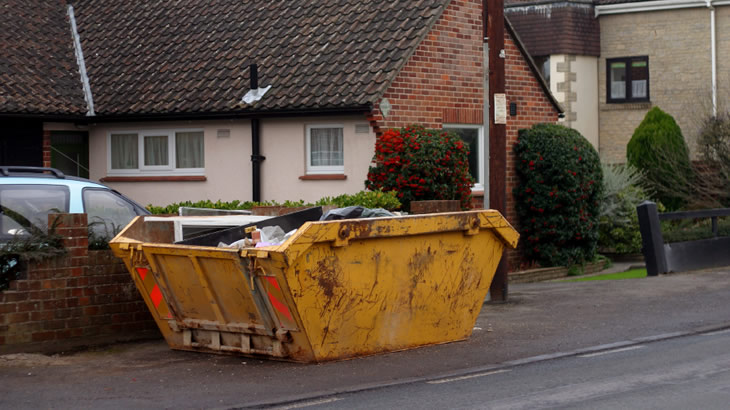Construction skip
Contents |
[edit] Introduction
In construction, a skip is a container that is used for holding waste and debris produced by works such as building, demolition, landscaping, and so on. When full it is loaded onto the back of a lorry and taken away for the waste to be disposed of. A skip may also be used to deliver materials to site before then being used as waste storage.
Skips typically have two trapezoid sides, the shorter edge at the bottom and the longer edge at the top. This results in sloping faces at both ends, sometimes with hinges allowing them to be opened for manual loading or unloading. Lugs on each of the top corners allow chains to be attached so they can be lifted on and off lorries.
[edit] Materials
Skips are suitable for the following materials:
- General waste.
- Inert materials such as concrete, aggregates, ceramics, steel and so on.
- Spoil and soil waste.
- Recyclable materials.
Some of the materials and items that are not suitable for skips include:
- Asbestos and other hazardous materials.
- Batteries, fluorescent tubes, gas canisters, and so on.
- Electrical appliances and equipment.
- Cooling equipment and air conditioning units.
- Liquids such as oil, petrol, paint and so on.
[edit] Skip types and sizes
Types of skip include:
- Open skip: The most common type, which has no top and is often referred to as a ‘builder’s skip’.
- Closed skip: Has a top which makes it more secure and means that it cannot be over-filled.
- Roll-on roll-off (RORO) skip: Similar to open skips but are rolled on and off lorries with a hook rather than being lifted with chains.
- Mobile skip: Set on a four-wheeled trailer.
Skips are available in several different sizes. In the UK, the volume measurement for a skip is still the cubic yard instead of being metric. Sizes include:
- Mini skip: 2 cubic yards (approx. 20-30 bin bags), suitable for small domestic works.
- Small skip: 4 cubic yards (approx. 30-40 bin bags), suitable for small-scale works.
- Small builder’s skip: 6 cubic yards (approx. 50-60 bin bags).
- Large builder’s skip: 8 cubic yards (approx. 60-80 bin bags), this is the most common size.
- Maxi skip: 12 cubic yards (approx. 100-120 bin bags), used for larger works.
[edit] Hiring a skip
Hiring a skip is an important part of site waste management and efficient waste disposal. The larger they are, the are cheaper per cubic yard of waste removed, but if the skip is too large for the amount of waste then it will not be fully used.
When deciding on a skip operator, it is worthwhile checking with the Environment Agency that they are correctly licenced to carry waste. This can be done by acquiring their waste carrier licence number and checking its validity. It may also be sensible to acquire a copy of the operator’s public liability insurance details, in case of accidents or damage to property when delivering or collecting the skip.
If a skip is to be placed on a public highway, a skip hire permit should be applied for and if necessary, a parking suspension put in place. Councils may not permit maxi skips to be placed on a public highway.
Skips will generally have to comply with local authority requirements relating to positioning, signage, lighting and so on.
For more information, see Getting a skip hire permit.
Skips are typically collected within 1 or 2 weeks of them being delivered, but this can generally be adjusted on request. Prices for skip hire will vary depending on locaion, duration, size, the type of material being stored. It is important to ensure that the skip is not overfilled. Instead it should be filled till it is level. If it is overfilled, the operator may charge more to take it away or ask that excess waste is removed.
[edit] Related articles on Designing Buildings
Featured articles and news
Infrastructure that connect the physical and digital domains.
Harnessing robotics and AI in challenging environments
The key to nuclear decommissioning and fusion engineering.
BSRIA announces Lisa Ashworth as new CEO
Tasked with furthering BSRIA’s impressive growth ambitions.
Public buildings get half a million energy efficiency boost
£557 million to switch to cleaner heating and save on energy.
CIOB launches pre-election manifesto
Outlining potential future policies for the next government.
Grenfell Tower Inquiry announcement
Phase 2 hearings come to a close and the final report due in September.
Progress from Parts L, F and O: A whitepaper, one year on.
A replicated study to understand the opinion of practitioners.
ECA announces new president 2024
Electrical engineer and business leader Stuart Smith.
A distinct type of countryside that should be celebrated.
Should Part O be extended to existing buildings?
EAC brands heatwave adaptation a missed opportunity.
Definition of Statutory in workplace and facilities management
Established by IWFM, BESA, CIBSE and BSRIA.
Tackling the transition from traditional heating systems
59% lack the necessary information and confidence to switch.
The general election and the construction industry
As PM, Rishi Sunak announces July 4 date for an election.
Eco apprenticeships continue help grow green workforce
A year after being recognised at the King's coronation.
Permitted development rights for agricultural buildings
The changes coming into effect as of May 21, 2024.






















